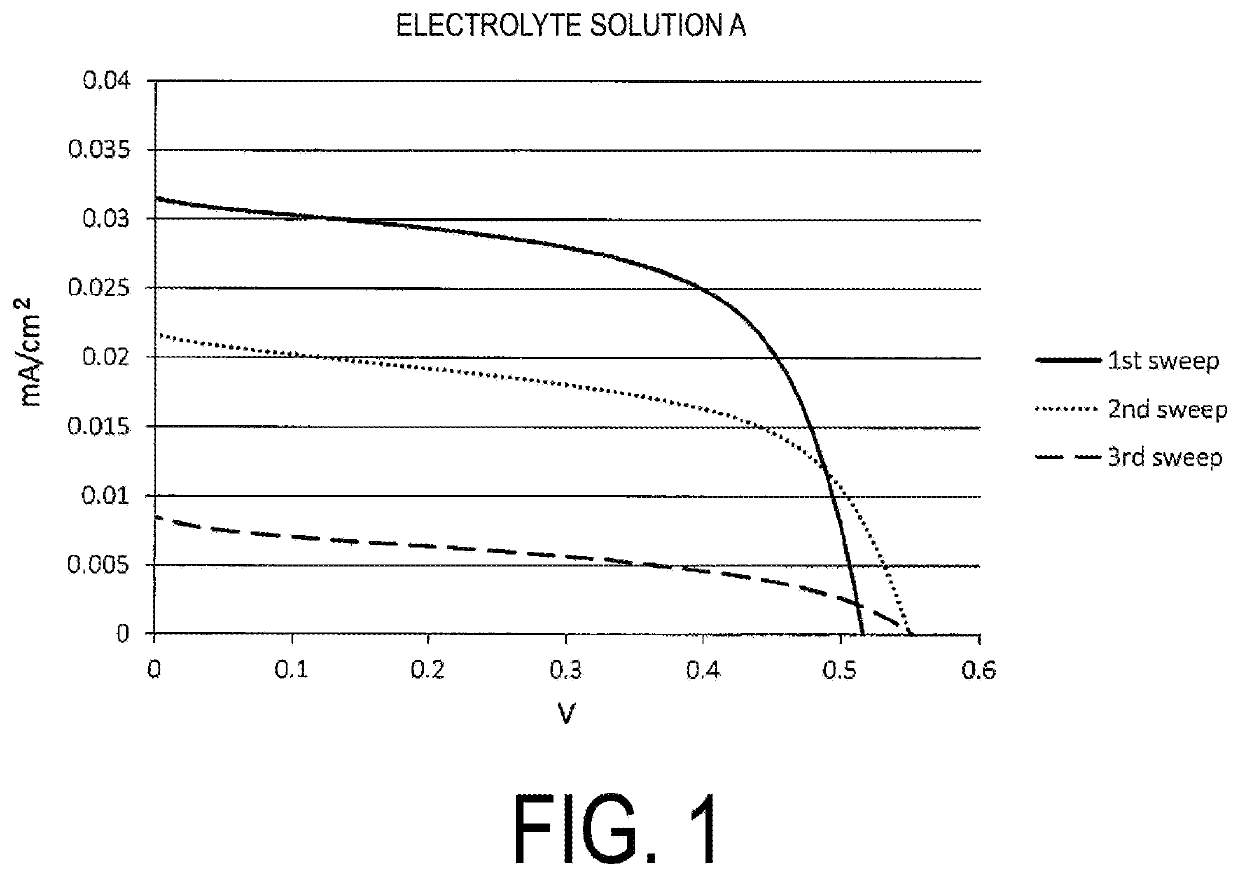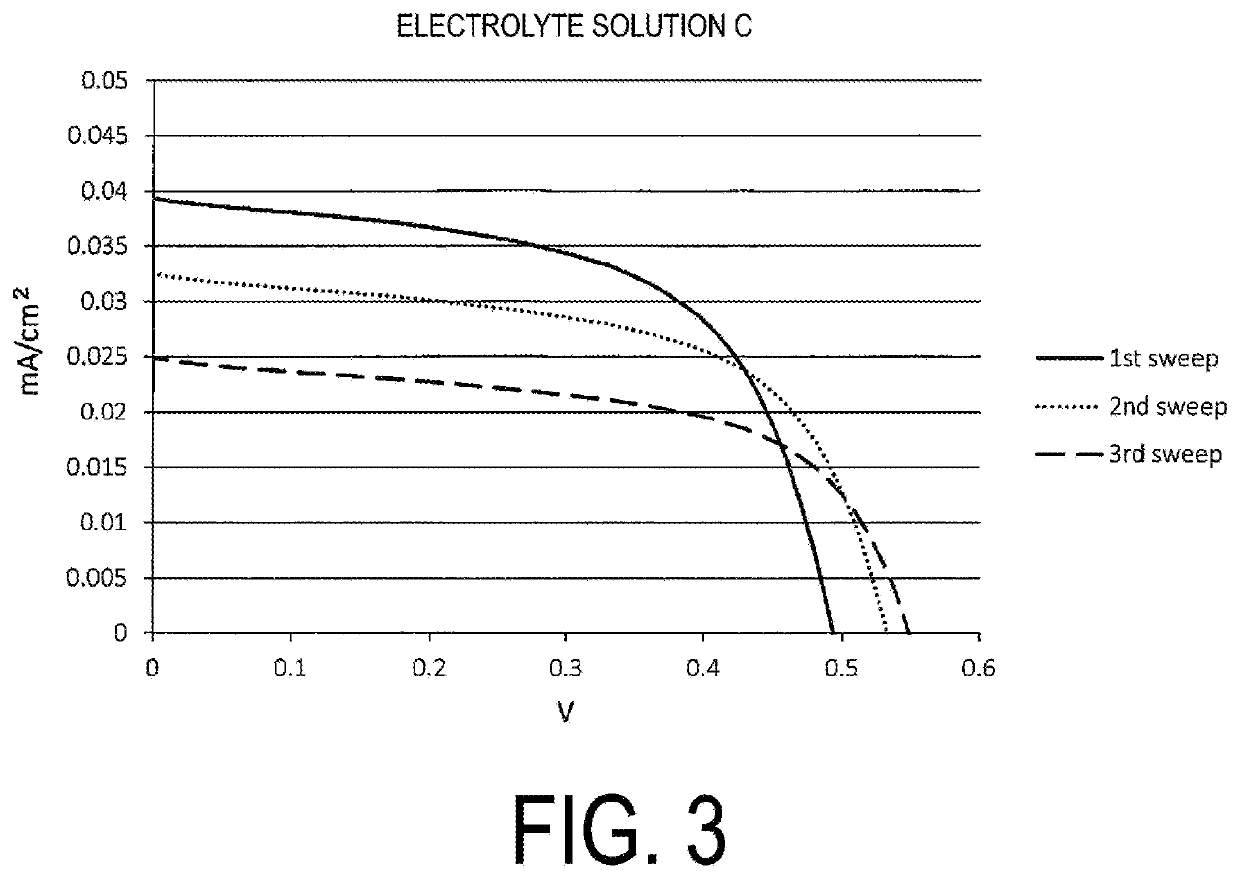Electrolyte composition and use thereof
Pending Publication Date: 2020-09-17
DAICEL CHEM IND LTD
View PDF0 Cites 0 Cited by
- Summary
- Abstract
- Description
- Claims
- Application Information
AI Technical Summary
Benefits of technology
The present invention provides a convenient and highly transparent electrolyte composition for dye-sensitized solar cells that contains iodine, a specific sulfur compound, and a basic nitrogen compound. This electrolyte composition has increased short-circuit current and improved output characteristics, even at high levels of iodine content. This helps to enhance the performance of dye-sensitized solar cells.
Problems solved by technology
However, the solar cells have problems including low conversion efficiency for weak light, such as room light.
However, this electrolyte layer, when containing iodine, has reduced transparency due to coloration and reduced photoelectric conversion efficiency.
However, this electrolyte layer also has reduced transparency due to coloration and reduced photoelectric conversion efficiency.
However, this electrolyte composition not only needs cyclodextrin but also requires synthesis of the iodine-cyclodextrin inclusion compound in advance and control of the particle size of the inclusion compound poorly soluble in the medium, thus reducing handling property and productivity.
In addition, the iodine-cyclodextrin inclusion compound is poorly soluble in the medium, and only a limited amount can be added, thus failing to provide sufficient iodine concentration.
Method used
the structure of the environmentally friendly knitted fabric provided by the present invention; figure 2 Flow chart of the yarn wrapping machine for environmentally friendly knitted fabrics and storage devices; image 3 Is the parameter map of the yarn covering machine
View moreImage
Smart Image Click on the blue labels to locate them in the text.
Smart ImageViewing Examples
Examples
Experimental program
Comparison scheme
Effect test
examples
[0064]Hereinafter, the present invention is described in greater detail based on examples, but the present invention is not limited to these examples.
the structure of the environmentally friendly knitted fabric provided by the present invention; figure 2 Flow chart of the yarn wrapping machine for environmentally friendly knitted fabrics and storage devices; image 3 Is the parameter map of the yarn covering machine
Login to View More PUM
 Login to View More
Login to View More Abstract
Provided is an electrolyte composition containing iodine (A), a sulfur compound (B) excluding organic salts, and a basic nitrogen compound (C). This electrolyte composition may have a light transmittance at a wavelength of 400 nm in an optical path length of 1 cm of 30% or higher. The sulfur compound (B) may be at least one selected from the group consisting of a thiol, a sulfide, and a disulfide (particularly a thiol having a chain or cyclic alkane backbone, such as a linear or branched C4-18 alkanethiol). The basic nitrogen compound (C) may be an amine (particularly a pyridine). A proportion of the sulfur compound (B) may be approximately from 0.1 to 2 times the molar amount of the basic nitrogen compound (C). The electrolyte composition may further contain an iodide salt. The electrolyte composition may be an electrolyte solution for dye-sensitized solar cells. The electrolyte composition can be easily and conveniently prepared and, although contains iodine, is highly transparent and also has reduced coloration.
Description
TECHNICAL FIELD[0001]The present invention relates to an electrolyte composition that can be utilized for an electrolyte solution for dye-sensitized solar cells and the like, and a use of the electrolyte composition.BACKGROUND ART[0002]Solar cells are attracting attention as a “clean energy” source with a small environmental load and are actually put into practical use. However, the solar cells have problems including low conversion efficiency for weak light, such as room light. Thus, development is actively carried out to improve the photoelectric conversion efficiency of the solar cells by improving a photoelectric conversion device itself. On the other hand, development to improve an electrolyte solution is also carried out to improve the photoelectric conversion efficiency of the solar cells.[0003]JP 2009-76369 A (Patent Document 1) discloses, as a dye-sensitized solar cell with improved electromotive force, maximum output, and recycling properties, a dye-sensitized solar cell i...
Claims
the structure of the environmentally friendly knitted fabric provided by the present invention; figure 2 Flow chart of the yarn wrapping machine for environmentally friendly knitted fabrics and storage devices; image 3 Is the parameter map of the yarn covering machine
Login to View More Application Information
Patent Timeline
 Login to View More
Login to View More IPC IPC(8): H01G9/20
CPCH01G9/2013Y02E10/542H01G9/2004H01G9/2031H01G9/2059Y02P70/50
Inventor FUKUI, KAZUHISA
Owner DAICEL CHEM IND LTD
Features
- R&D
- Intellectual Property
- Life Sciences
- Materials
- Tech Scout
Why Patsnap Eureka
- Unparalleled Data Quality
- Higher Quality Content
- 60% Fewer Hallucinations
Social media
Patsnap Eureka Blog
Learn More Browse by: Latest US Patents, China's latest patents, Technical Efficacy Thesaurus, Application Domain, Technology Topic, Popular Technical Reports.
© 2025 PatSnap. All rights reserved.Legal|Privacy policy|Modern Slavery Act Transparency Statement|Sitemap|About US| Contact US: help@patsnap.com



